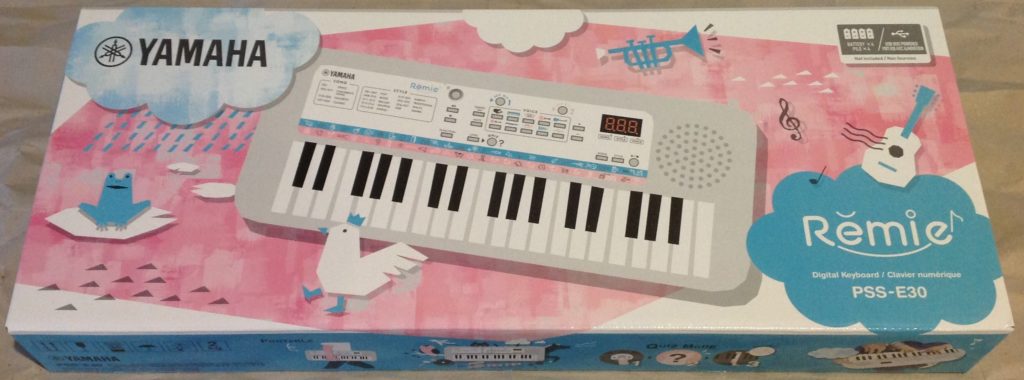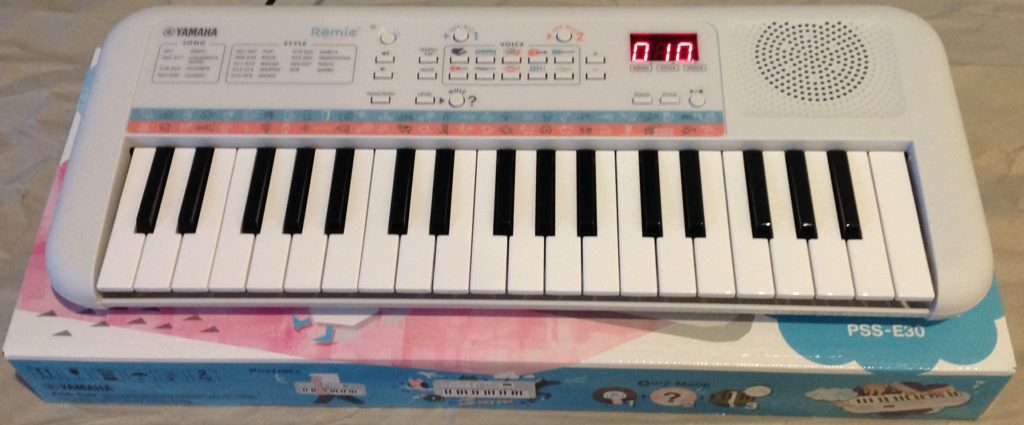One of the big benefits of moving out west is time with our grandson. The lad went to Kindermusik as a pre-toddler and already has a good sense of rhythm and an appreciation for music. I dropped a few quick beats with the MODX and he started dancing with a big smile on his face! Editorial: Folks, arts are an essential part of a child’s education.
Last Fall, Yamaha announced a trio of mini-sized PSS keyboards: PSS-E30 (Remie), PSS-F30, PSS-A50. The three products have distinct product markets: young kids, older kids, teens and young adults, respectively. Of course, those are mere marketing constructs since one or more of these ‘boards might appeal to jaded musicians and other folks, too.
There is another market segment which, perhaps, Yamaha did not explicitly intend — modders, AKA “hacks”. This article will focus on Remie (PSS-E30) as an instrument. I’ve already taken a screwdriver to Remie and will eventually post an article about Remie internals and other topics of interest to hacks.
“Keen On Keys” posted a nicely produced PSS-A50 demo on YouTube. The A50 appeals to musicians who want to put together simple tracks from arpeggios (musical phrases). Looks like fun! The A50 is the only member of the family which can record songs and, most importantly, the only member which sends/receives MIDI over USB. Neither Remie nor the PSS-F30 have a USB interface although they use a micro-B connector for power.
The PSS-F30 is the “Honey I Shrunk the PSR-F50” arranger keyboard. The F30 essentially has the same sounds, styles and songs as the F50/F51. The F30 could be the mini-keyboard for arranger enthusiasts on the go. That said, after taking a peak inside the A50 (see the YouTube demo) and the Remie, the program and waveform memory is quite small and the sound is not up to the same quality level of the current E-series arranger keyboards. Something had to be sacrificed to achieve such a small size, low cost and longer battery life (1.5 Watts versus 6 Watts). YMMV.
Circling back to Remie… I had to have one, er, buy one for our grandson. Naturally, I needed to check out Remie to make sure that it works on Christmas morning. 🙂 Oh, that includes a peak inside to make sure everything is in its place.
I wish that I could review Remie from a two year-old’s point of view. That review will wait for Christmas day. In the meantime, here’s my take from a musician’s perspective.
The keybed
Remie has 37 mini keys. To my touch, they are indeed the same as the Yamaha Reface series keyboards. I play the Yamaha Reface YC (drawbar and combo organs) at weekly choir rehearsal. I must say, Remie’s keybed feels better than the YC! Maybe I have worn in the YC’s keys or maybe manufacturing quality is better now. Bottom-line, the mini-keys are pretty darned good.
I think the keybed will hold up when kids go to work on it. Our grandson has watched older kids play piano, and he presses keys instead of whacking on them like most kids. [I trust him enough that we play side-by-side on MODX and Genos.] I haven’t been very gentle with the Reface YC and yet, the keys hold up. Parents shouldn’t worry about key quality. The mini-size should be good for kids, too; most adults find these mini-keys cramped.
I have one main complaint with 37 keys: the note range is sometimes too small for some songs. I wish the keybed was 49 keys with middle C in its rightful place. I like to play the left hand part in the two octaves below middle C. With 37 keys, that leaves only one octave above middle C for the melody and I often run out of keys in the right hand.
Remie is no different. Further, Remie does not have octave shift buttons which would alleviate the short range issue somewhat.
Sound
As I mentioned above, voice quality is comparable to early Yamaha portable keyboards, back in the day when waveform (sound) memory was tight. I’m sure Remie is using recycled sounds; that’s why it’s inexpensive.
The voices do not respond to touch. Thus, when you play the keys soft or hard, you get the same volume and timbre. One can make the overall volume louder and softer using front panel buttons. That’s it for dynamics.
So far, I’ve tested Remie through its built-in speaker, headphones (3.5mm stereo) jack and studio monitors. Of course, an 8cm speaker is not going to produce earth-shaking bass. It is adequate for the family room and reproduces the built-in voices surprisingly well. I think Yamaha learned a lesson with Reface and its disappointing built-in stereo speakers. As a result, I always play the YC through JBL Charge 2 speakers, not the YC’s built-in speakers. Unlike Reface, I could actually see myself using Remie’s speaker. BTW, the sound does not distort when pushed to the MAX.
Plugging into the headphone jack turns off the internal speaker. As expected, sound quality improves dramatically through decent headphones or external speakers. Parents should be careful when kids use headphones. Remie can drive headphones painfully loud. Fortunately, there is a “Volume Limit” function that sets the maximum Master Volume level. Parents should definitely set the “Volume Limit” before letting kids use headphones.
Sound quality through studio monitors is quite good! The sound is clear and is comparable to other entry- and mid-range arranger keyboards.
Overall, I’m tempted to take Remie to rehearsal to see if either the F30 or A50 might make a good ultra-portable rehearsal keyboard. I wouldn’t consider playing one of these keyboards in front of a congregation (audience), however. No such quality qualms about the YC which carried me through a few gigs during the move.
Styles and songs
The styles and songs are what we expect from a low-end Yamaha keyboard. The styles are pleasant enough. However, this isn’t a $5,000 Genos. 🙂 The styles do not have A and B sections or auto-fill. I wouldn’t expect kids to be arranging songs unless they are Mozart reincarnated.
The only concerns that I have in this area are operational. Can a young kid figure out how to play a song? Can a youngster play along with a style? I think adult supervision is needed here. I recommend that adults read the manual since operation is not intuitive, especially if you don’t have experience with Yamaha arranger keyboards.
The sound effects (SFX) shouldn’t be too hard to figure out. There are two dedicated front panel buttons to select either the blue kit or the pink kit. Kids shouldn’t have trouble with that.
Remie has a number of deep features controlled by the “FUNCTION” button. This is definitely beyond young kids. Parents should read the manual for more information. Functions include tuning, transpose, metronome, etc.
Yamaha arrangers usually apply effects like reverberation, chorusing, (guitar) distortion and so forth. Musos often complain about too much reverb. I’m happy to report that Yamaha has set the reverb to a pleasant level — a good thing because there isn’t any way to change the amount of reverb. Reverberation appears to be the only effect on Remie.
Musical scales and smart chords
Remie has a Smart Chord feature which is enabled right out of the box. Smart Chord is designed to keep chords within a chosen musical scale, i.e., the C scale AKA “all of the white keys.” Smart Chord lets a kid play one note chords.
If you’re a musician, however, the result may surprise you. Playing a I-IV-V (C-F-G in the C scale) progression sounds right, but hit that VII (B) and uh-oh. The VII chord plays Bm-flat5, the diminished chord. Play with Remie and you may raise a kid with an ear for “interesting” harmonies. Hope you like dissonance. 🙂
BTW, one of the functions sets the Smart Chord key in case you want to play with Smart Chords in some other key than C.
Summary
Well, Remie is a pretty good — although basic — keyboard instrument. It will be interesting to see what young, two year-old hands will do! It’s well-made and is a worthy impulse purchase.
If Remie isn’t what you’re looking for, maybe take a look at my review of the Yamaha PSS-A50? You might also want to take a peek inside of Remie, too.
Copyright © 2019 Paul J. Drongowski


